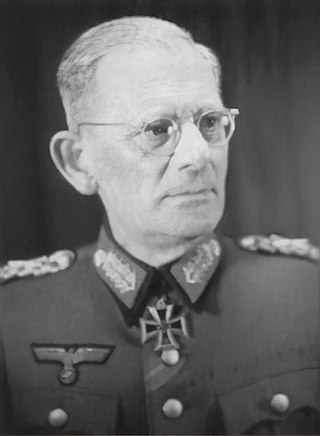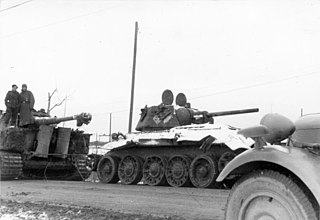
The Third Battle of Kharkov was a series of battles on the Eastern Front of World War II, undertaken by Army Group South of Nazi Germany against the Soviet Red Army, around the city of Kharkov between 19 February and 15 March 1943. Known to the German side as the Donets Campaign, and in the Soviet Union as the Donbas and Kharkov operations, the German counterstrike led to the recapture of the cities of Kharkov and Belgorod.

Maximilian Maria Joseph Karl Gabriel Lamoral Reichsfreiherr von und zu Weichs an der Glon was a German Generalfeldmarschall in the Wehrmacht of Nazi Germany during World War II.
Army Group Centre was the name of two distinct strategic German Army Groups that fought on the Eastern Front in World War II. The first Army Group Centre was created during the planning of Operation Barbarossa, Germany's invasion of the Soviet Union, as one of the three German Army formations assigned to the invasion.

Operation Winter Storm, a German offensive in December 1942 during World War II, involved the German 4th Panzer Army failing to break the Soviet encirclement of the German 6th Army during the Battle of Stalingrad.
Army Group A was the name of three distinct army groups of the Heer, the ground forces of the Wehrmacht, during World War II.

Operation Little Saturn was a Red Army offensive on the Eastern Front of World War II that led to battles in Don and Chir rivers region in German-occupied Soviet Union territory in 16–30 December 1942.
The 1st Panzer Army was a German tank army that was a large armoured formation of the Wehrmacht during World War II.

The 8th Panzer Division was a formation of the WehrmachtHeer. The division was formed by reorganising the 3rd Light Division in October 1939. It was transferred to the west and fought in the Battle of France, in May 1940, and the German invasion of the Balkans in April 1941. Soon after the division advanced towards Leningrad under Army Group North in Operation Barbarossa, and would remain on the eastern front for the remainder of the war. Staying on defensive fronts, it saw action in the relief of Kholm in 1942, Orel and the withdrawals of Army Group Centre in 1943, until transferred to Army group South. The division then fought in a series of retrograde movements, back through Ukraine, into Hungary and finally into Silesia and surrender in May 1945.

The 12th Panzer Division was an armoured division in the German Army, established in 1940.

The 4th Panzer Army, operating as Panzer Group 4 from its formation on 15 February 1941 to 1 January 1942, was a German panzer formation during World War II. As a key armoured component of the Wehrmacht, the army took part in the crucial battles of the German-Soviet war of 1941–45, including Operation Barbarossa, the Battle of Moscow, the Battle of Stalingrad, the Battle of Kursk, and the 1943 Battle of Kiev.
Army Group B was the name of four distinct German army group commands that saw action during World War II.

The Second Battle of Kiev was a part of a much wider Soviet offensive in Ukraine known as the Battle of the Dnieper involving three strategic operations by the Soviet Red Army and one operational counterattack by the Wehrmacht, which took place between 3 November and 22 December 1943.

The Raid on Tatsinskaya was a Soviet armoured raid deep into the German rear conducted by 24th Tank Corps under the command of Major General Vasily Mikhaylovich Badanov in late December 1942. It took place during Operation Little Saturn, on the heels of the successful encirclement of the Wehrmacht's 6th Army in the Battle of Stalingrad. The raid was designed to force the Germans to divert forces attempting to relieve the 6th Army. The Soviet force captured its objective, the Luftwaffe's airlift hub at the Tatsinskaya Airfield. The Soviet forces destroyed over 72 aircraft on the ground, but was left cut off and without supplies. Despite the loss of most of the tank corps during the ensuing breakout, the raid was a great operational victory.

The German Seventeenth Army was a field army of Nazi Germany during World War II.
The 19th Panzer Division was an armoured division in the German Army, the Wehrmacht, during World War II. It was created from the 19th Infantry Division.

The 14th Panzer Division was an armoured division in the German Army during World War II. It was created in 1940 by the conversion of the 4th Infantry Division.

The 88th Infantry Division was a major fighting formation of the German Army (Wehrmacht). It was created in December 1939, and first saw combat in the Battle of France, and was then posted to security duties. From December 1941, the division was shifted to the southern sector of the Eastern Front, where it fought until February 1944 when it was encircled near Cherkassy and virtually destroyed.
The 9th Flak Division was a Flak division of the German Luftwaffe in World War II which saw action on the Eastern Front. It is most notable for its role in the Battle of Stalingrad. Another formation with the same name was deployed to the Eastern Front and saw combat in the Kuban bridgehead.
The LIX Army Corps, initially known as the Higher Command for Special Deployment LIX was an army corps of the German Wehrmacht during World War II. The formation was active between 1940 and 1945.












